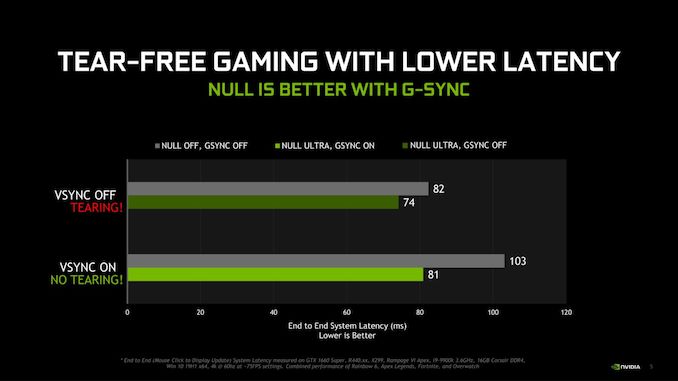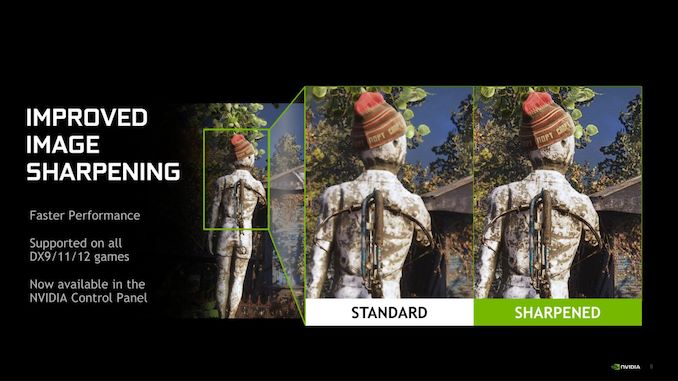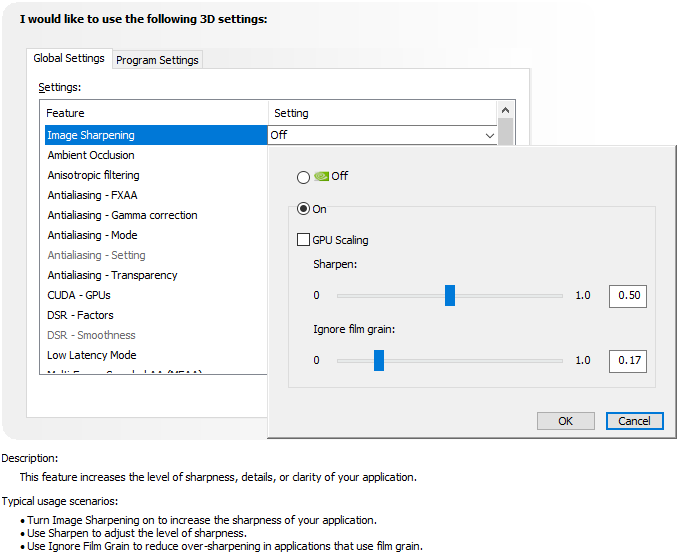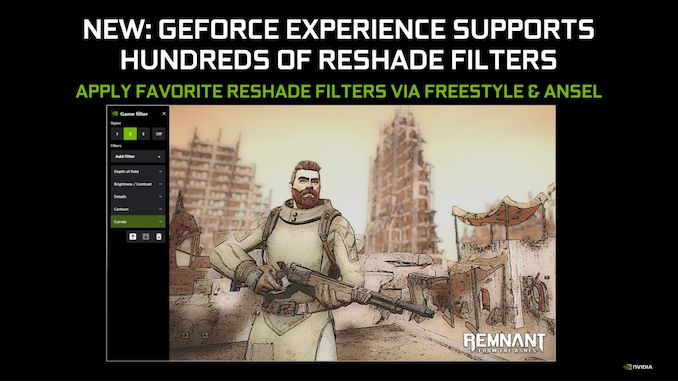The NVIDIA GeForce GTX 1660 Super Review, Feat. EVGA SC Ultra: Recalibrating The Mainstream Market
by Ryan Smith on October 29, 2019 9:00 AM ESTNVIDIA Updates Low-Latency Mode, Adds Reshade Filter Support & Image Sharpening Becomes a Driver Feature
While not a feature specifically limited to or being introduced particularly introduced for the GeForce GTX 1660 Super series, with their driver shipping out today (441.07), NVIDIA is also releasing some new driver features for all of their recent cards, which should be of interest to gamers interested in controlling latency as well as those interested in post-process filtering.
First off, NVIDIA is updating their ultra-low latency mode to better support G-Sync. This feature was first introduced into the NVIDIA driver stack earlier this year, and at the time it wasn’t designed to take into account variable refresh displays. Specifically, it left G-Sync users stock between taking tearing with V-sync off, or taking higher latencies with V-sync on. So, starting with NVIDIA’s newest drivers, it can be better combined with G-Sync, allowing the variable refresh aspects of G-Sync to be used in low latency mode to still keep latency to a minimum, all the while v-sync is kept on to avoid tearing.
The numbers being distributed by NVIDIA show that the latency with G-Sync + ULL + V-Sync on are comparable to that of V-sync off without G-Sync or ULL turned on, so this essentially allows variable refresh and v-sync to be turned on with no latency penalty, or cutting it down significantly from where it was before.
Meanwhile, NVIDIA is also making a couple of image post-processing filter-related changes for their new drivers. Their image sharpening post-process filter, which was introduced a few months ago as part of the Freestyle filter system, has now been promoted to a driver feature. This means that the image sharpening filter no longer requires Freestyle/GeForce experience to use, and, according to NVIDIA, it now works with all DirectX 9, 11, and 12 games, with plans to add OpenGL and Vulkan support soon.
Overall, the control panel-based version of the filter is very similar to the freestyle version of the filter, with adjustments for how strong the sharpening effect is. New to the driver version is the option to allow GPU-upscaling – with the driver upscaling any sub-native resolution to the display’s native resolution – with NVIDIA stating that Turing GPUs will also get a 5-tap filter on top of the usual bilinear upscaling. NVIDIA reports that this new version is also faster than the Freestyle version, though they haven’t listed any specific numbers.
Finally, for even more post-processing options with Freestyle (and Ansel), NVIDIA is adding support for 3rd party ReShade filters. Originally developed as an injector system for adding post-process filters to games – essentially another form of graphics modding – ReShade has been around for several years now. With similar goals as NVIDIA’s own Freestyle system, the company has decided to build in support for ReShader filters to Freestyle, allowing users to enable the filters at a driver level rather than injecting them into running games.
It should be noted, however, that while the basics of ReShade are easy to grasp, the fine print on conditional support is rather extensive. In short, NVIDIA is limiting support for ReShade filters on certain “competitive” games, presumably for cheating/fairness reasons. In the case of those games, only certain official ReShade filters (~30 in all) can be used, and custom filters cannot be used at all. Otherwise, all official and custom filters can be used in non-competitive games.
The Test
As is usually the case for launches without reference hardware, we’ve had to dial down our EVGA card slightly to meet NVIDIA’s reference specifications. So, along with testing it in its as-shipped configuration, it has also been tested with the GPU underclocked by 45MHz, bringing the clockspeeds in line with the reference specs. It’s these values we’re using for our generic GTX 1660 Super results as well as overall performance commentary.
Meanwhile on the driver front, we’re using the latest drivers from both NVIDIA and AMD for their cards. For NVIDIA cards, this is 441.07, and for AMD cards it’s AMD’s Radeon Software 19.10.2.
| CPU: | Intel Core i9-9900K @ 5.0GHz |
| Motherboard: | ASRock Z390 Taichi |
| Power Supply: | Corsair AX1200i |
| Hard Disk: | Phison E12 PCIe NVMe SSD (960GB) |
| Memory: | G.Skill Trident Z RGB DDR4-3600 2 x 16GB (17-18-18-38) |
| Case: | NZXT Phantom 630 Windowed Edition |
| Monitor: | Asus PQ321 |
| Video Cards: | AMD Radeon RX 5700 AMD Radeon RX 590 AMD Radeon RX 580 AMD Radeon R9 380 NVIDIA GeForce RTX 2060 Founders Edition NVIDIA GeForce GTX 1660 Ti EVGA GeForce GTX 1660 Super SC Ultra NVIDIA GeForce GTX 1660 NVIDIA GeForce GTX 1060 6GB Founders Edition NVIDIA GeForce GTX 1060 3GB NVIDIA GeForce GTX 960 |
| Video Drivers: | NVIDIA Release 441.07 AMD Radeon Software Adrenalin 2019 Edition 19.10.2 |
| OS: | Windows 10 Pro (1903) |















65 Comments
View All Comments
flyingpants265 - Monday, November 4, 2019 - link
It's ridiculous because I've been hearing about 4k for so long, and most of us are STILL gaming at 1080p. A 1080p card still costs $229 when most of us have them already. I am not willing to sink that amount of money into something that is already obsolete.RX570, RX580, and GTX1060 are cheap and plentiful on the used market for $65-120.
DanNeely - Tuesday, October 29, 2019 - link
"Truthfully, I’m not even sure NVIDIA’s GPU binning operations changed for this product, or if they just had partners slap TU116-300 GPUs on a PCB wired for GDDR6."I'd assume a bit of tweaking around the edges because of the different memory controllers. Base 1660's can use a chip with a dud GDDR6 controller, 1660S needs that but can tolerate a dud GDDR5 one.
AshlayW - Tuesday, October 29, 2019 - link
I'm fairly certain the memory controller supports both GDDR6 and GDDR5 concurrentlyDanNeely - Tuesday, October 29, 2019 - link
Different IO pinouts seems to require at least some parts to be different.DominionSeraph - Tuesday, October 29, 2019 - link
>Instead, this is a pure virtual launch, with all of the cards on the market being partner designs.Anandtech: where a hard launch is called a paper launch because the chip manufacturer only handed out a paper saying it was now ok to pair the TU116-300 that has been selling for months with GDDR6 instead of making a reference board which nobody needed.
Ryan Smith - Tuesday, October 29, 2019 - link
To be sure, virtual does not mean paper in this context. It's actually NVIDIA's official term for a video card launch where they don't make any retail cards of their own. It's not derogatory in any way.yeeeeman - Tuesday, October 29, 2019 - link
The title of this article should be "Nvidia preparing for Radeon RX5500".Xeres14 - Tuesday, October 29, 2019 - link
Not bad. Good for a specific budget but it seems the extra $ for the 2060 is worth it.Showtime - Tuesday, October 29, 2019 - link
If you're talking bang for the buck, the 2060 is bad. Bang for buck cards would probably be RX570/580 on sale regularly, this new card, then AMD 5700, then 5700x, then the $500 2070 super. The rest of the lineup is terrible performance for the dollar. Used cards are relative bargains. 8GB AMD RX cards are under $100, and used 10 series cards finally dropping again. $400 1080 ti's, and sub $300 1080/1070 ti's are tough to beat.Shlong - Tuesday, October 29, 2019 - link
I replaced a GTX 960 4GB in one of my old systems (6 core 4930k @ 4.5) with a $210 1070 TI 8GB from ebay and my old laptop with an Acer Predator Helios 300 (6 core 9750H paired with 1660Ti 6GB) which I picked up for under $1000 during the Prime deal. What a night and day difference!